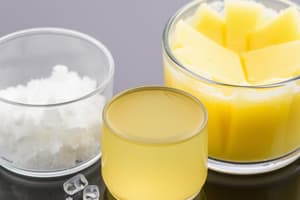Podcast
Questions and Answers
Which of the following statements about the particle model of matter is INCORRECT?
Which of the following statements about the particle model of matter is INCORRECT?
- Particles in a solid are more spread out than particles in a liquid. (correct)
- Particles are always in motion.
- All particles in one substance are the same.
- Particles are attracted to each other.
Which of the following is NOT a factor that affects the rate of dissolving?
Which of the following is NOT a factor that affects the rate of dissolving?
- The type of container used to hold the solution. (correct)
- Particle size of the solute
- Temperature
- Agitation
Which of the following is an example of a heterogeneous mixture?
Which of the following is an example of a heterogeneous mixture?
- Sugar dissolved in water.
- Sand and water (correct)
- Air
- Saltwater
What is the difference between a saturated solution and a supersaturated solution?
What is the difference between a saturated solution and a supersaturated solution?
Which of the following statements about density is TRUE?
Which of the following statements about density is TRUE?
Which of the following is an example of a substance that is soluble in water?
Which of the following is an example of a substance that is soluble in water?
Why is water considered the universal solvent?
Why is water considered the universal solvent?
Which of the following is an example of a pure substance?
Which of the following is an example of a pure substance?
Which of the following is an example of a compound?
Which of the following is an example of a compound?
Which of the following WHMIS symbols is used to represent a corrosive substance?
Which of the following WHMIS symbols is used to represent a corrosive substance?
What formula represents Mechanical Advantage (MA) in hydraulic systems?
What formula represents Mechanical Advantage (MA) in hydraulic systems?
Which aspect measures how well a device performs its intended function?
Which aspect measures how well a device performs its intended function?
In a hydraulic system, what happens to the pressure when the area of the input piston is decreased while the force remains constant?
In a hydraulic system, what happens to the pressure when the area of the input piston is decreased while the force remains constant?
How does technological development in mechanical devices primarily relate to changes in society?
How does technological development in mechanical devices primarily relate to changes in society?
What is the formula for calculating Work in mechanical systems?
What is the formula for calculating Work in mechanical systems?
Which term is most closely associated with the physical appearance and structure of a mechanical device?
Which term is most closely associated with the physical appearance and structure of a mechanical device?
What key factor is required for a hydraulic system to function effectively?
What key factor is required for a hydraulic system to function effectively?
What describes how quickly and easily a mechanical device assists the user?
What describes how quickly and easily a mechanical device assists the user?
When discussing the environment, which aspect highlights the development of more efficient vehicles?
When discussing the environment, which aspect highlights the development of more efficient vehicles?
If the input force in a hydraulic system is halved while the area remains constant, what happens to the output force?
If the input force in a hydraulic system is halved while the area remains constant, what happens to the output force?
Which of the following statements correctly describes the relationship between temperature and viscosity for liquids and gases?
Which of the following statements correctly describes the relationship between temperature and viscosity for liquids and gases?
A diver is submerged in water and remains stationary. Which of the following statements is TRUE about the buoyant force acting on the diver?
A diver is submerged in water and remains stationary. Which of the following statements is TRUE about the buoyant force acting on the diver?
Which of the following methods is MOST suitable for separating a mixture of sand and salt?
Which of the following methods is MOST suitable for separating a mixture of sand and salt?
A simple machine is MOST accurately defined as:
A simple machine is MOST accurately defined as:
Which of the following is NOT a simple machine?
Which of the following is NOT a simple machine?
If the work input is 100 joules (J) and the work output is 80 J, what is the efficiency of the machine?
If the work input is 100 joules (J) and the work output is 80 J, what is the efficiency of the machine?
Which of the following scenarios demonstrates the concept of Pascal's Law?
Which of the following scenarios demonstrates the concept of Pascal's Law?
Which of the following is NOT a characteristic of a fluid?
Which of the following is NOT a characteristic of a fluid?
Which of the following statements about the density of an object is CORRECT?
Which of the following statements about the density of an object is CORRECT?
If a block of wood floats in water, which of the following is TRUE about the buoyant force acting on the wood?
If a block of wood floats in water, which of the following is TRUE about the buoyant force acting on the wood?
Flashcards
What does WHMIS stand for?
What does WHMIS stand for?
Workplace Hazardous Materials Information System - a system used to communicate information about hazardous materials in the workplace.
Particle model of matter
Particle model of matter
The theory that everything is made up of tiny, moving particles with spaces between them. These particles are always in motion and attracted to each other.
Pure substance
Pure substance
A pure substance is a single type of matter with a fixed composition. It cannot be broken down into simpler substances by physical means.
Elements
Elements
Signup and view all the flashcards
Compounds
Compounds
Signup and view all the flashcards
Mixtures
Mixtures
Signup and view all the flashcards
Heterogeneous mixture
Heterogeneous mixture
Signup and view all the flashcards
Homogeneous mixture
Homogeneous mixture
Signup and view all the flashcards
Solution
Solution
Signup and view all the flashcards
Soluble
Soluble
Signup and view all the flashcards
Mechanical Advantage (Hydraulic)
Mechanical Advantage (Hydraulic)
Signup and view all the flashcards
Mechanical Advantage Formula
Mechanical Advantage Formula
Signup and view all the flashcards
Pressure (Hydraulic)
Pressure (Hydraulic)
Signup and view all the flashcards
Efficiency (Device)
Efficiency (Device)
Signup and view all the flashcards
Effectiveness (Device)
Effectiveness (Device)
Signup and view all the flashcards
Function (Device)
Function (Device)
Signup and view all the flashcards
Design (Device)
Design (Device)
Signup and view all the flashcards
Advances in Science (Technology)
Advances in Science (Technology)
Signup and view all the flashcards
Changes in Society (Technology)
Changes in Society (Technology)
Signup and view all the flashcards
Changes in Environment (Technology)
Changes in Environment (Technology)
Signup and view all the flashcards
Viscosity
Viscosity
Signup and view all the flashcards
Buoyancy
Buoyancy
Signup and view all the flashcards
Density
Density
Signup and view all the flashcards
Incline Plane
Incline Plane
Signup and view all the flashcards
Pulley
Pulley
Signup and view all the flashcards
Wedge
Wedge
Signup and view all the flashcards
Complex Machine
Complex Machine
Signup and view all the flashcards
Work
Work
Signup and view all the flashcards
Hydraulic System
Hydraulic System
Signup and view all the flashcards
Pascal's Law
Pascal's Law
Signup and view all the flashcards
Study Notes
WHMIS
- WHMIS stands for Workplace Hazardous Materials Information System
- Used to identify hazardous materials and how to handle them
- Presented through signs indicating the dangers of a substance or product
Matter
- Everything is composed of tiny particles
- All particles within a substance are identical
- Particles have spaces between them
- Particles are constantly moving
- Particles attract each other
Classification of Matter
- Matter is classified into pure substances and mixtures
- Pure substances are further divided into compounds and elements
- Mixtures are categorized into heterogeneous and homogeneous mixtures
- Homogeneous mixtures are a type of solution
- Heterogeneous mixtures include mechanical mixtures, colloids, and suspensions
Solutions
- A solution is formed by dissolving one substance in another
- Dissolving occurs due to attractions between particles
- Solvent dissolves the solute to form a solution
- Soluble means able to dissolve, insoluble means unable to dissolve
- Water is a universal solvent, dissolving many materials
- Factors affecting dissolving: agitation, temperature, particle size
- Unsaturated: less than maximum solute
- Saturated: maximum solute
- Supersaturated: more than maximum solute at a specific temperature
Concentration
- Measures the amount of solute in a solvent
- There's a maximum amount of solute that can dissolve in a solvent
Density
- Measures how much mass is packed into a specific volume
- Solids are tightly packed, liquids loosely, gases widely (exceptions exist)
- Density decreases with increasing temperature, and increases with decreasing temperature
- Formula: Density (d) = Mass (m) / Volume (v)
Viscosity
- Measures a fluid's resistance to flow
- High viscosity: thick, flows slowly
- Low viscosity: thin, flows easily
- Viscosity depends on the attractive forces between particles
- Viscosity of liquids decreases with increasing temperature, and increases with decreasing temperature, the inverse applies in the case of gas
Buoyancy
- Upward force exerted by a fluid, opposing gravity
- Objects float if buoyant force exceeds gravity, sink if gravity exceeds buoyant force
- Density of the fluid affects buoyant force
- Density of a fluid, increases with increased density
Separating Mixtures
- Mechanical sorting: physically separating materials
- Evaporation: separating soluble solids from liquids
- Filtration: separating insoluble solids from liquids
- Chromatography: separating components based on different movement rates in a solvent
- Simple distillation: separating a solvent from a solution
- Fractional distillation: separating different liquids from a mixture
Simple Machines
- Inclined plane: ramp to lift loads with less force
- Screw: cylinder with a spiral groove
- Pulley: cable moving on a wheel
- Wedge: inclined plane forced into an object
- Wheel and axle: two wheels (different diameters) turning together
- Lever (3 classes): Class 1 (fulcrum in the middle), Class 2 (load in the middle), Class 3 (effort in the middle)
Complex Machines
- Systems of simple machines performing a task together
- System: group of machines/devices completing a task
- Subsystem: individual device within a system with a specific function
- Mechanical devices: subsystems that transfer energy/power
The Science of Work
- Work depends on force and distance (in the direction of force)
- Work = Force x Distance
- Energy and work are closely related, without energy there's no work
- Machines don't reduce the amount of work, just the force needed
Efficiency
- How well a device performs the desired task/outcome
- Efficiency = (Work output / Work input) x 100%
Hydraulics
- Hydraulic systems use liquid pressure to move loads
- Increase mechanical advantage, allows for small forces to have large effects
- Input piston applies pressure to fluid, output piston transfers pressure
- Pascal’s Law: Pressure applied in an enclosed fluid is transmitted throughout
- Mechanical advantage (MA) = Output force / Input force
- Pressure = Force / Area
- Work = Force x Distance
Mechanical Devices
- Efficiency: effectiveness, speed, and ease of use
- Effectiveness: desired outcome
- Function: purpose/task
- Design: physical form
- Technology development driven by advances in science, societal changes (easier work, safer/cheaper), and environmental factors (vehicles efficiency)
Studying That Suits You
Use AI to generate personalized quizzes and flashcards to suit your learning preferences.
Description
This quiz covers key concepts in chemistry related to the classification of matter, including pure substances and mixtures. It also introduces WHMIS, the system used to identify hazardous materials in the workplace. Test your understanding of these fundamental principles!




